Complete Solutions to Subjective of chapter PROPERTIES OF SOLIDS AND FLUIDS of Class 11 book with complete answers and questions
| Class 11 | PHYSICS |
| Chapter | PROPERTIES OF SOLIDS AND FLUIDS |
| CENGAGE PHYSICS | Subjective |
| Number Of Questions | 16 |
| Academic Year | 2023-24 |
A bob of mass `m` hangs from the ceiling of a smooth trolley car which is moving with a constant acceleration a. If young's modulus, radius and length of the string are `Y, r` and `I`, respectively, find the (a) stress in the string and (b) extension of the string when it makes a constant angle relative to vertical.
 02:44View Solution
02:44View SolutionA smooth uniform, string of natural length `l`, cross-sectional area `A` and Young’s modulus `Y` is pulled along its length by a force `F` on a horizontal surface. Find the elastic potential energy stored in the string.
02:40View SolutionA narrow capillary tube is dipped `10 cm` below water surface and a liquid bubble of radius `2 mm` formed at the lower end by blowing air through the tube.
a. Calculate the excess pressure due to surface tension.
b. What is the pressure required in the tube in order to blow a hemispherical bubble at its end in water?
The surface tension of water at temperature of the experiment is `7.30xx10^(-2) N//m`. 1 atmospheric pressure `= 10^(5) Pa`, density of water `= 1000 kg//m^(3)`07:04View SolutionA thin plate of large area is placed midway in a gap of height `h` filled with oil of viscosity and the plate is pulled at constant velocity `v `by applying the same drag force on the plate. If a lighter oil of viscosity `eta` is then substituted in the gap. it is found that for the velocity `v`, and the same drag force as previous case the plate is located unsymmetrically in the gap but parallel to the walls. Find `eta` in terms of distance from nearer wall to the plane `y`.
 03:48View Solution
03:48View SolutionWhen a vertical capillary of length with the sealed upper end was brought in contact with the surface of a liquid, the level of this liquid rose to the height `h`. The liquid density is `rho`, the inside diameter the capillary is `d`, the contact angle is `theta`, the atmospheric pressure is `rho_(0)`. Find the surface tension of the liquid. (Temperature this process remains constant.)
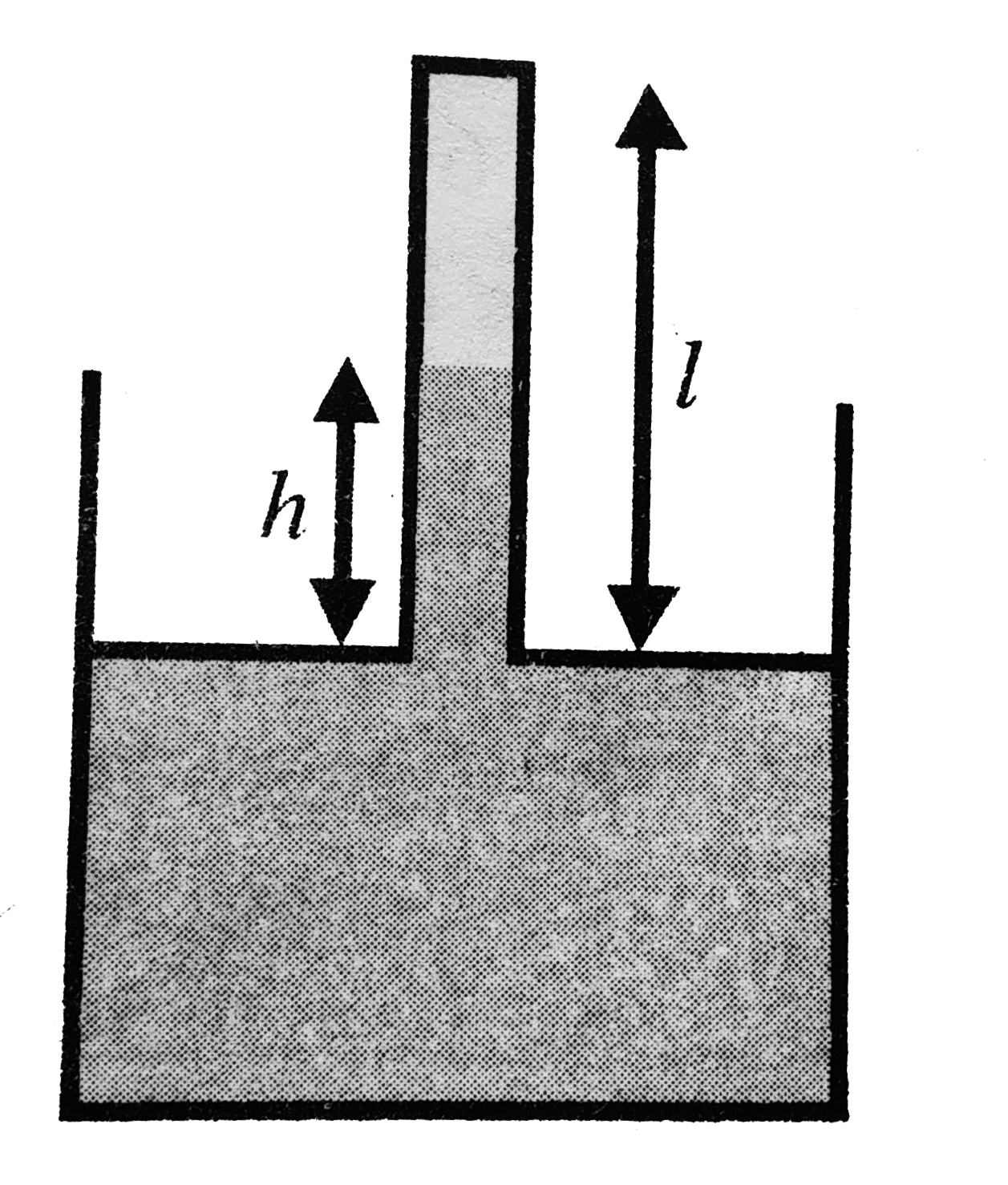 02:48View Solution
02:48View SolutionA rubber cord has a cross -sectional area `1 mm^(2)`and total un-stretched length`10.0cm`. It is stretched to `12.0 cm` and then released to project a missile of mass 5.0 g. Taking young's modulus Y for rubber as `5.0xx10^(8) N//m^(2)`.Calculate the velocity of projection .
03:46View SolutionTwo wires of diameter `0.25 cm`, one made of steel and other made of brass, are loaded as shown in the figure. The unloaded length of the steel wire is `1.5 m` and that of brass is `1.0 m`. Young's modulus of steel is `2.0 xx 10^(11)`Pa and that of brass is `1.0 xx 10^(11)` Pa. Compute the ratio of elongations of steel and brass wires. `(/_\l_("steel"))/(/_\l_("brass"))=?`
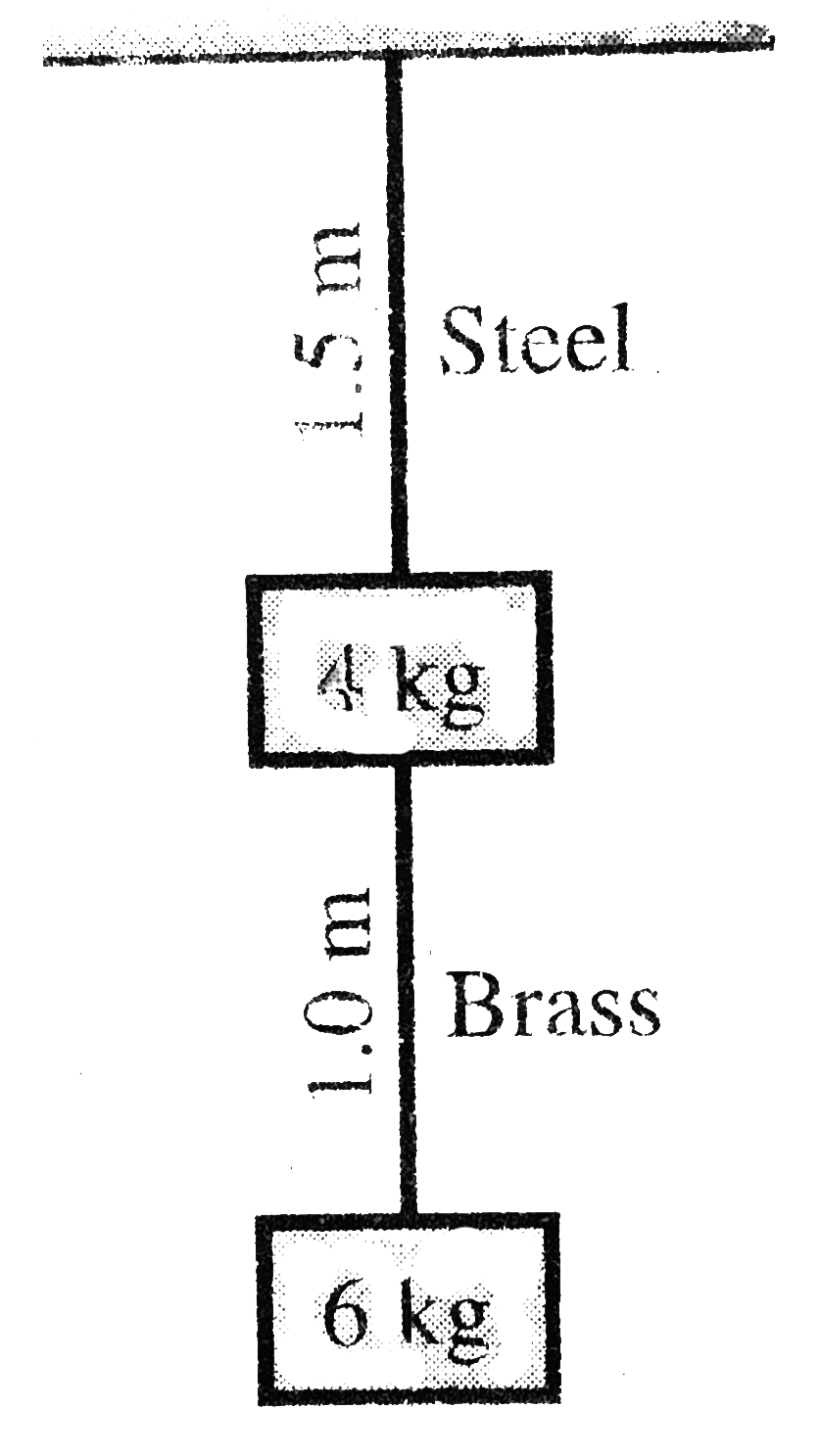 03:03View Solution
03:03View SolutionA steel rod of length `l_(1) = 30 cm` and two identical brass rod of length `l_(2)= 20 cm` each support a light horizontal platform as shown in Fig. Cross-sectional area of each of the three rods is `A = 1 cm^(2)`. A vertically downward force `F= 5000 N` is applied on the platform. Young's modulus of elasticity for steel `Y_(s)=2xx10^(11)Nm^(-2)` and brass `Y_(b) = 1 xx 10^(11) Nm^(-2)`. Find stress (in `MPa`) developed in a. Steel rod b. Brass rod
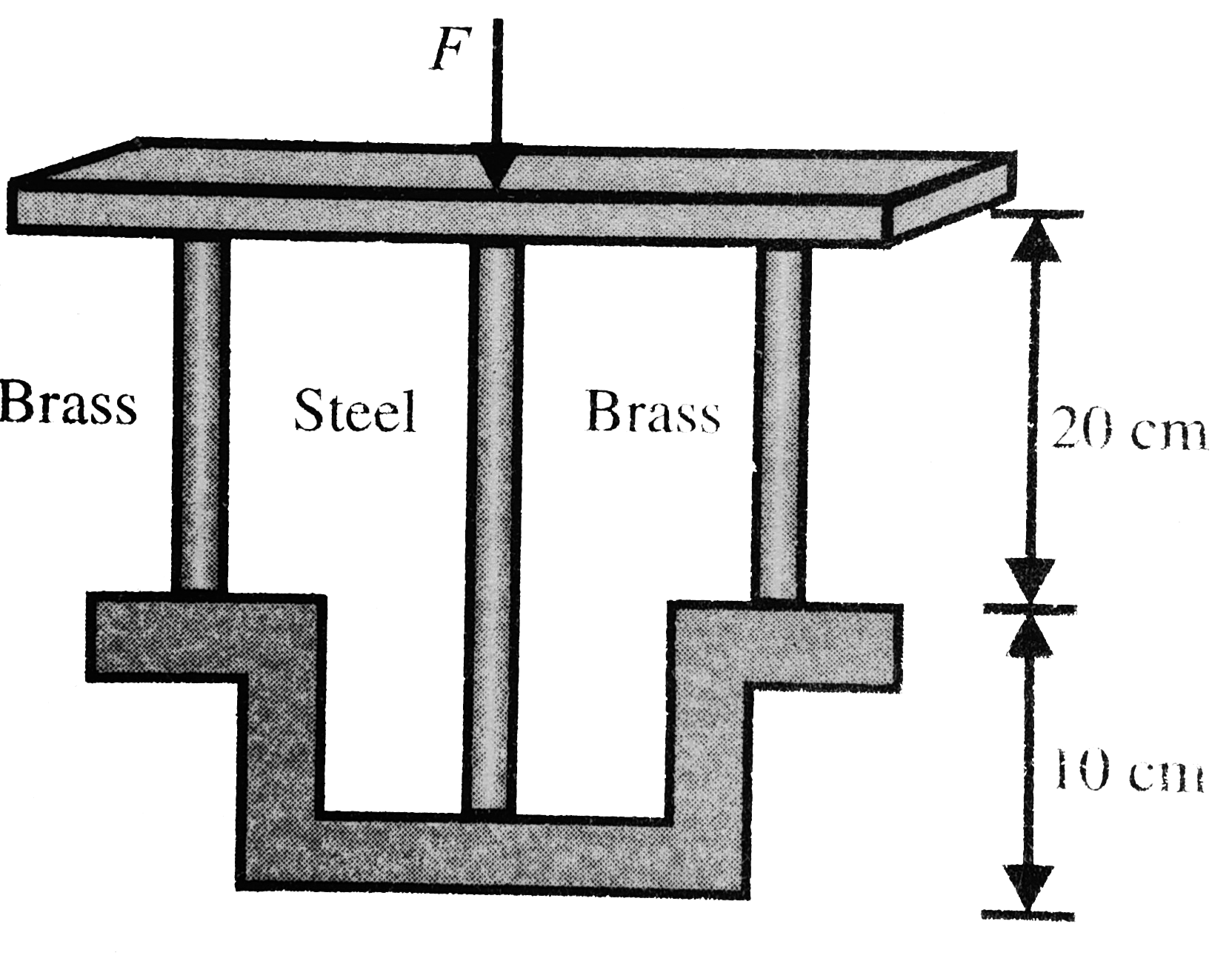 03:51View Solution
03:51View SolutionThe two wires shown in figure are made of the same material which has a breaking stress of `8xx10^8Nm^-2`. The area of cross section of the upper wire is `0.006 cm^2` and that of the lower wire is `0.003 cm^2`. The mass `m_1=10 kg`, `m_2=20kg` and the hanger is light. a. Find the maximum load that can be put on the hanger without breaking a wire. Which wire will break first if the load is increased? b. Repeat the above part `m_1=10 kg and m_2=36kg`.
 06:19View Solution
06:19View SolutionA copper wire of negligible mass, `1 m` length and cross-sectional area `10^(-6) m^(2)` is kept on a smooth horizontal table with one end fixed. A ball of mass `1 kg` is attached to the other end. The wire and the ball are rotating with an angular velocity of `20 rad//s`. If the elongation in the wire is `10^(-3) m`.
a. Find the Young's modulus of the wire (in terms of `xx 10^(11) N//m^(2)`).
b. If for the same wire as stated above, the angular velocity is increased to `100 rad//s` and the wire breaks down, find the breaking stress (in terms of `xx 10^(10) N//m^(2)`).04:56View SolutionAn amusement park ride consists of airplane shaped cars attached to steel rods. Each rod has a length of `20.0 m` and a cross-sectional area of `8.00 cm^(2)`. Young's modulus for steel is `2 xx 10^(11) N//m^(2)`.
a. How much is the rod stretched (in `mm`) when the ride is at rest ? (Assume that each car plus two people seated in it has a total weight of `2000 N`.)
b. When operating, the ride has a maximum angular speed of `sqrt(19/5) rad//s`. How much is the rod stretched (in mm) then?
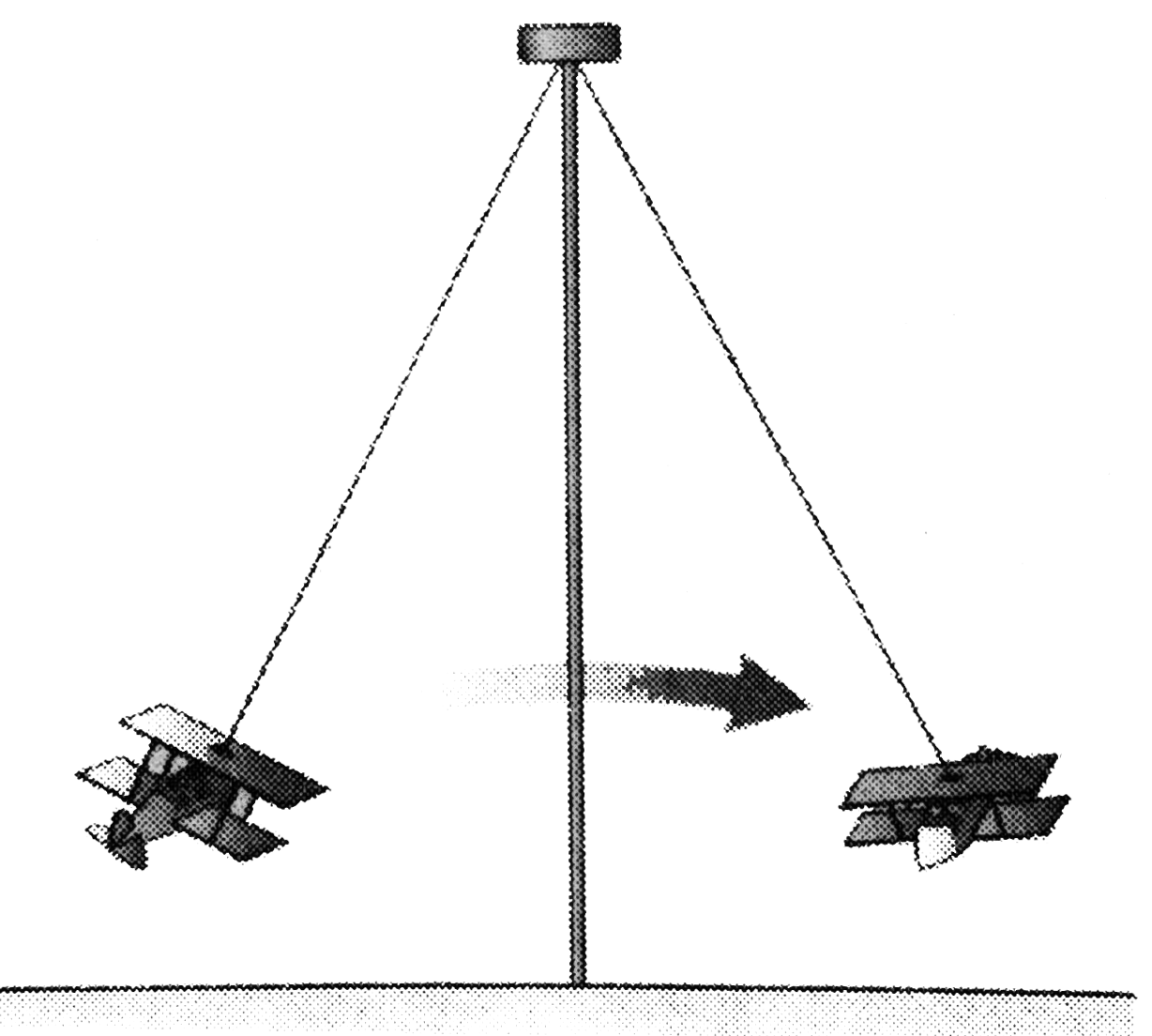 03:55View Solution
03:55View SolutionA capillary tube of length (i) `l = 60 cm`, (ii) `l = 50 cm` and radius `r = 1//4 mm` is immersed vertically into water. Find the capillary rise in both cases. Angle of contact `= 0^@`. Take coefficient of surface tension as `72 "dyne"//cm, g = 1000 cm s^(-12)`.
01:41View SolutionAn annular disc of radius `r_(1 )= 10 cm` and `r_(2) = 5 cm` is placed on a water surface. Find the surface tension force on the disc if we want to pull it from water surface. Take coefficient of surface tension as `sigma= 7 xx10^(-3) N//m, g = 10 ms^(-12)`.
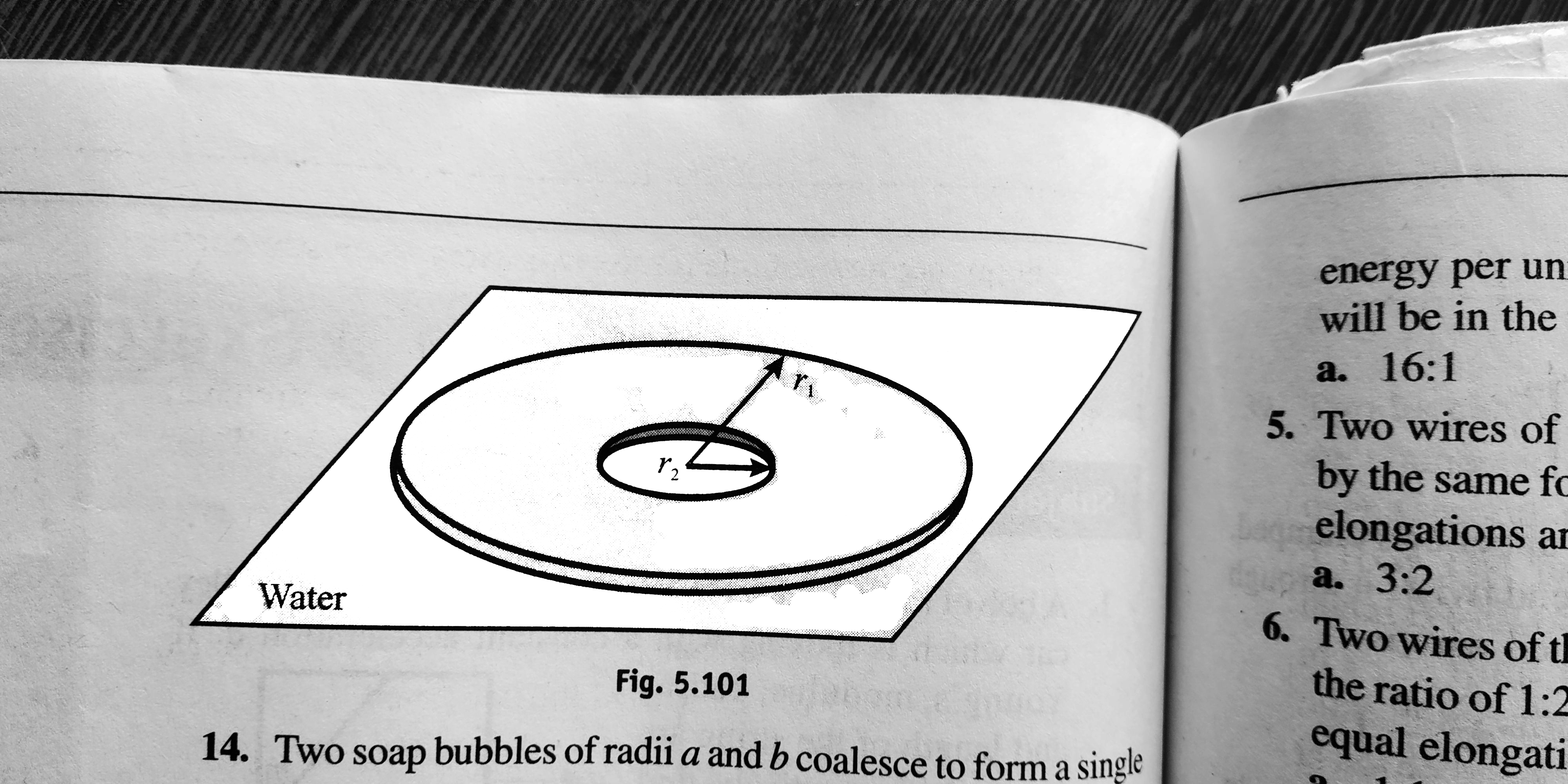 02:40View Solution
02:40View SolutionTwo soap bubbles of radii `a` and `b` combine to form a single bubble of radius `c`. If `P` is the external pressure, then the surface tension of the soap solution is
04:38View SolutionCalculate the pressure indise a small air bubble of radius `0.01 mm` situated at a depth of `h=20 m` below the fre surface of liquid of density `rho_(1)=10^(3)kg//m^(3), rho_(2)=800km//m^(3)` and surface tension `T_(2)=7.5xx10^(-2)N//m.` The thickness of the first liqid is `h_(1)=15 m` and `h_(2)=25m`.
 06:00View Solution
06:00View SolutionA mercury drop of radius `R` is sprayed into `n` droplets of equal size. Calculate the energy expended if surface tension of mercury is `T`.
02:23View Solution
Subjective questions and complete solutions for chapter PROPERTIES OF SOLIDS AND FLUIDS of CENGAGE PHYSICS (ENGLISH) of Class 11
